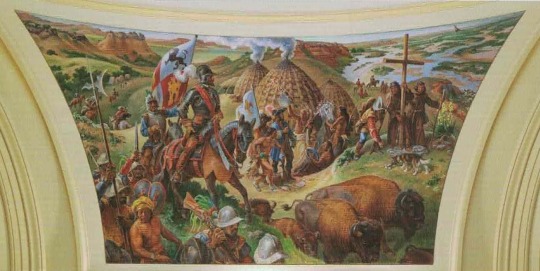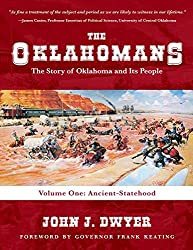
The SpaniardsThe first three centuries of Western civilization contact with Oklahoma came in the historical context of the mercantilist rivalry between the world’s great powers, at that time all European. Predicated on the assumption of a limited amount of resources in the world, represented by a nation’s stock of bullion (gold and silver), mercantilist powers such as England, Spain, France, and the Netherlands believed that to obtain a larger slice of this finite “pie" one nation must wrest it from another. This could be accomplished by favorable trading activities-exporting a greater amount than one imports - or by success in war and the subsequent treaties, which could deliver additional resources from one country to another. Thus unfolded a crucial plank of mercantilist thought-possessing as many colonies as possible in order to mine the raw materials from them, ship those to the mother country, produce finished products from the imports, and then ship those back to the colony and other countries for sale. Mercantilism stands at variance with the American founders’ consensus economic notions of laissez faire, or free trade. The famed Scotsman Adam Smith systematized the latter philosophy in his landmark 1776 work The Wealth of Nations. Laissez faire, in contrast to mercantilism, argues against restrictive tariffs toward other nations, the always selective governmental subsidization of industry with citizens’ tax revenues, and the federal financing of internal improvements (infrastructure) to any extent beyond what is necessary. Laissez faire also supports limited government involvement in every area of life, particularly economic matters; low tariffs to stimulate trade between cities, states, and countries; and the notion of an ever-expanding economic pie, rather than a static one. It anticipates vigorous economic competition taking place alongside mutually beneficial results with no specter of serious international tension due to the “win-win” rather than the mercantilist “dog-eat-dog” process between individuals, companies, and nations alike. Discovery and Exploration 1541–1820, the first of Miami, Oklahoma artist Charles Banks Wilson’s epic cycle of four 13 x 27 foot murals that adorn the Oklahoma State Capitol. It depicts famed Spanish explorer Francisco Vasquez de Coronado atop his armored horse in the present-day Oklahoma Panhandle, amidst the Catholic missionaries who accompanied him, Wichita Indians, buffalo, and the Antelope Hills, a key landmark for travelers. (Courtesy Charles Banks Wilson and the Oklahoma State Senate Historical Preservation Fund, Inc., Photo John Jernigan)
Read the entire Oklahoma story in John J. Dwyer's Media The Oklahomans: The Story of Oklahoma and Its People volume 1 of a 2-part series on the 46th state and the people who make this state very special. |

|
|
0 Comments
Leave a Reply. |
John Dwyer's Oklahoma HistoryAuthor John Dwyer takes us on a voyage through time, to discover Oklahoma is ways we've never fully understood. The hardbound pictorial of volume 1 is available for a limited time at up to 40% off, using this link.
Archives
January 2024
Novelist and Oklahoma native Ralph Ellison said, "You have to leave home to find home", an apt description of the journey of John Dwyer, author and general editor of The Oklahomans. The Dwyer family roots were firmly transplanted from Ireland to Oklahoma by John's great-grandfather and grandfather, the latter who settled in Oklahoma City in 1909, just two years after Oklahoma achieved statehood. Although born in Dallas, TX, John was relocated to Oklahoma when his widowed mother returned to her home when he was two years old.
It would be on Oklahoma soil that his mother instilled in him his love for history, and coupled with his unusually creative imagination, it soon became apparent that John not only liked to hear great stories of legend and history, but to make up his own as well. It would be out of a sense of divine purpose that he would use that creativity in response to a higher calling in the years to come. John began a career in journalism during his high school days when he served in a variety of roles, including news and sports reporter, for the Duncan Banner, a daily newspaper in his small Oklahoma hometown. He was the youngest sports editor in the newspaper's history by the time he attended the University of Oklahoma on a journalism scholarship. He graduated in 1978 with a bachelor of arts and sciences degree in journalism. Dwyer further developed his journalistic skills in radio as a play‐by‐play football and basketball announcer for several radio stations. He won the coveted position of sports director for the University of Oklahoma's 100,000 watt KGOU‐FM radio station. For seven years, he provided live, on‐air reports to America's largest radio networks of University of Oklahoma college football games. Except for a year in England during 6th grade, John lived in the Sooner State for 28 years before returning to Dallas in 1986 to attend Dallas Theological Seminary where he earned his Master of Biblical Studies. While there, Dwyer worked part time on the sports staff of The Dallas Times Herald, which at the time owned one of the five largest circulations of any daily newspaper in Texas. It was in Texas that he also met and married his wife Grace in 1988 and settled down to start his family. In the spring of 1992, Dwyer and his wife founded the Dallas‐Fort Worth Heritage newspaper, which would grow to a circulation of 50,000 per month at the time of its sale, after nearly a decade, to new owners. The Heritage pioneered innovative features such as full color photography and graphics, an expansive web site, a cluster of informative daily radio programs, and an aggressive, uncompromising brand of investigative news reporting unprecedented for contemporary news publications holding an orthodox Christian worldview. In 2006, at the urging of his family and the Oklahoma Historical Society, John returned to Oklahoma to tackle the colossal task of writing "The Oklahomans," which was endorsed as an official project of the Oklahoma Centennial Commission. He has completed volume 1 (Ancient‐Statehood) and a portion of volume 2 (Statehood‐Present), which releases in November 2018. He is now an Adjunct Professor of History and Ethics at Southern Nazarene University. He is former history chair at Coram Deo Academy, near Dallas, Texas. His books include the non‐fiction historical narrative "The War Between the States: America's Uncivil War" (Western Conservatory), the novel "When the Bluebonnets Come" (Bluebonnet Press), the historical novels "Stonewall" and "Robert E. Lee" (Broadman & Holman Publishers), and the upcoming historical novels "Shortgrass" and "Mustang" (Oghma Creative Media). John and Grace have one daughter and one grandson and live in Norman, Oklahoma. They are members of the First Baptist Church of Norman, where they serve in a variety of teaching, mission, and other ministry roles. Categories |









 RSS Feed
RSS Feed
